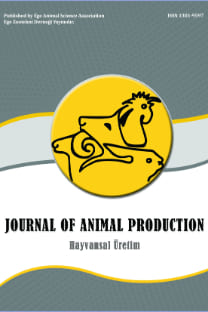Türkiye Et Koyunculuğu İçin Yeni Bir Gen Kaynağı: Dorper
Türkiye’nin coğrafi ve sosyo-kültürel yapısı koyun ve keçi yetiştiriciliğine uygun olmakla beraber koyun eti ülkemizin hemen hemen her kesiminde yaygın olarak tüketilmektedir. Koyun yetiştiriciliğini olanaklı kılan çoğu etmenin mevcut olmasına rağmen kırmızı et üretimi son derece yetersiz ve kişi başı kırmızı et tüketimi (9 kg/kişi/yıl) ise gelişmiş ülkelerin ortalamasının çok altındadır. Kırmızı et üretiminin yetersiz olmasının önemli sebeplerinden biri nitelikli damızlık yetersizliği ve sürdürülebilir üretim sistemlerinin uygulanmamasıdır. Et üretimini arttırmak amacı ile bugüne kadar devlet desteği ile çok farklı ülkelerden yüksek genetik kapasiteye sahip ve baba hattı olarak kullanılacak ırklar getirilmiş ancak bunların hiçbiri ülke bazında yaygınlaştırılamamış veya sürdürülebilir olamamıştır. Et koyunculuğu sektörü bağlamında kırmızı etin daha ekonomik üretilmesine ilişkin olarak tarafımızdan yapılan etüd ve araştırmalar sonucunda Dorper ırkının kimi özellikleri nedeniyle ülkemiz için uygun olduğu ve Gıda Tarım ve HayvancılıkBakanlığı nezdinde desteklenerek sürdürülebilir bir program dahilinde üretilmesinin son derece önemli olduğunu vurgulamakta fayda görüyoruz.
Anahtar Kelimeler:
Kırmızı et, sürdürülebilirlik, damızlık, ekstansif
A New Gene Source on Meat Sheep in Turkey: Dorper
Turkey’s topography and sociocultural make up is very suited to sheep and goat production. Lamb is also the preferred red meat option in most parts of Turkey. Although there are many elements to support lamb production, Turkey’s red meat production and consequently consumption (9kg/capita/year) is far below those of other developed countries. One of the main reasons for the production shortfall are the genetically deficient breeding stock and use of unsustainable husbandry methods. With the aim of improving meat production, Turkey has imported with government support high quality genetics, which were used as sire breed from many nations but has been unsuccessful in maintaining the genetic integrity within its national herd. It is important to emphasize that with regards to meat sheep sector, our research and field trials have shown that Dorper breed would be very suitable for our country due to its some traits in terms of producing red meat more feasible and also the support of Ministry for Food, Agriculture and Livestock to initiate a sustainable production program for this breed.
Keywords:
red meat, sustainability, stock breed, extensive.,
___
- Basson, W.D., Van Niekerk, B.D.H., Mulder A.M. 19 Growth and puberty of lambs raised under intensive conditions. Proc. S. Afr. Soc. Anim. Prod. 9:171-175. Cloete, S.W.P., De Villiers, T.T. 1987. Production parameters for a commercial Dorper flock on extensive pastures. S. Afr. J. Anim. Sci. 17: 1211
- Cloete, S.W.P., Snyman, M.A., Herselman, M.J. 2000. Productive performance of Dorper sheep. Small Rumin. Res. 36:119-136.
- Güney, O., M. Kaymakçı, O. Karaca, T. Savaş. 2005. Türkiye’ de Süt Keçisi ıslahının geleceği üzerine kimi öneriler. Ulusal Süt Keçiciliği Kongresi, 26-27 Mayıs 2005, İzmir, s. 20-25.
- Joubert, D.M. 1972. Effect of season and plane of nutrition on post-parturient anoestrus in Dorper sheep. Agroanimalia 4:19-24.
- Milne, C. 2000. The history of the Dorper sheep. Small Rumin. Res. 36: 99-102.
- Moss, G. E., Hess, B.W. J., Nel, E., Riley M.L., Stobart, R.H.L. McNeal, G., Russel, W.C. 2000. Technical Note: Comperative performance of Dorper-cross and Rambouillet lambs. Sheep Goat Res. J. 16:74-76.
- Notter, D.R., Greiner, S.P., Wahlberg, M.L. 2004. Growth and carcass characteristics of lambs sired by Dorper and Dorset Sires. J. Anim. Sci. 82: 132313
- Schoeman, S.J. 2000. A comparative assessment of Dorper sheep in different production environments and systems. Small Rumin. Res. 36:137-146.
- Schoeman, S.J., Van der Merwe, C.A. 1994. Improved efficiency in crossbreeding with FinnsheepxSubtropical ewe composites. In: C. Smith et al. (eds.), Proc. 5th Wld. Cong. Genetics Appl. Livest. Prod. Vol 18, Guelph, Canada, pp. 91
- Snowder, G. D., Duckett, S.K. 2003. Evaluation of the South African Dorper as a terminal sire breed for growth, carcass, and palatability characteristics. J. Anim. Sci. 81: 368-375.
- Webb, E.C., Casey, N.H. 1995. Genetic differences in fatty acid composition of subcutaneous adipose tissue in Dorper and SA Mutton Merino wethers at different live weights. Small Ruminant Res. 18: 81
- ISSN: 1301-9597
- Başlangıç: 1974
- Yayıncı: EGE ZOOTEKNİ DERNEĞİ
Sayıdaki Diğer Makaleler
Özdal GÖKDAL, Okan ATAY, Ali Kemali ÖZUĞUR, Vadullah EREN
Alternatif Bir Protein Kaynağı Lüpenin (Lupinus L.) Etlik Piliçlerin Beslenmesinde Kullanımı
Tatlı Patates (Ipomoea batatas) Yapraklarının Hayvan Beslemede Kullanımı
Organik Süt Üreten İşletmelerin Yapısal, Teknik ve Sosyo-Ekonomik Analizleri
Bahri BAYRAM, İbrahim AK, Vecihi AKSAKAL, Halit MAZLUM
Characterization of a Chicken x Peahen Intergeneric Hybrid Produced under Natural Mating
Hiromi HARA, Kei HANZAWA, Yutaka YOSHİDA, Seiki WATANABE
Malya Kuzularında Karkas Bölgelerinin Yağ Asidi Kompozisyonu
Ali KARABACAK, İbrahim AYTEKİN, Saim BOZTEPE
